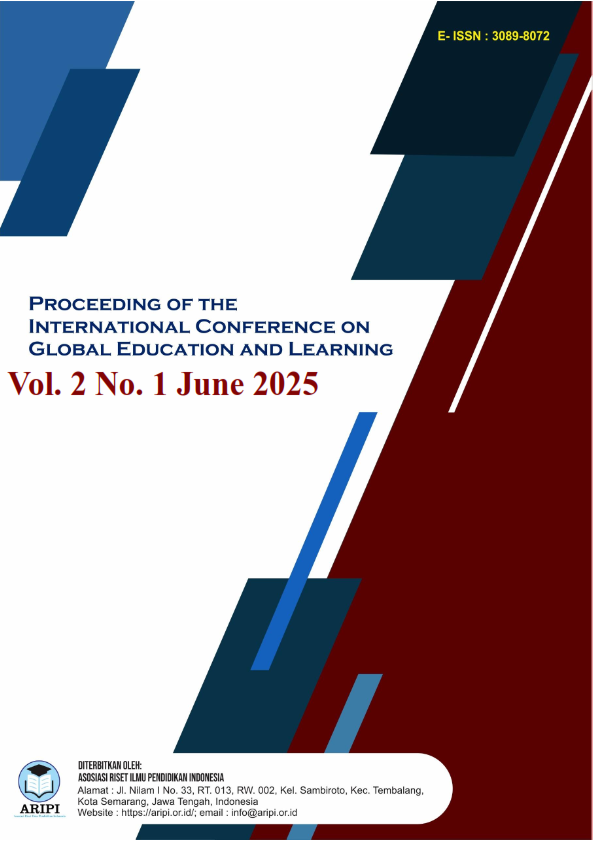From Classical Texts to Digital Platforms: Reconstructing Arabic Language Pedagogy for Multidisciplinary Education Goals
DOI:
https://doi.org/10.62951/icgel.v2i1.146Keywords:
Arabic language pedagogy, classical texts, curriculum innovation, digital transformation, hybrid learning model, Islamic higher education, multidisciplinary educationAbstract
Arabic language instruction has traditionally centered on classical Islamic texts, emphasizing rote memorization, mastery of grammar (naḥw), and rhetorical eloquence (balāghah), which, while preserving linguistic authenticity, often fail to meet the evolving educational demands of the 21st century. In an age marked by rapid technological advancement and shifting pedagogical paradigms, there is a critical need to reform Arabic teaching by integrating traditional methods with digital tools and interdisciplinary approaches. This study adopts a qualitative, literature-based methodology to explore both the foundational principles of classical pedagogy and recent innovations, including learning management systems, gamification, and AI-enhanced learning technologies. Through comparative analysis, the research identifies key disjunctions and overlaps between heritage-based teaching and modern digital practices. From this synthesis, the study proposes a reconstructed pedagogical model built on four core elements: cognitive-linguistic scaffolding, digital integration, sociocultural contextualization, and multidisciplinary instruction. This integrative approach not only fosters greater student engagement but also promotes character development in line with the objectives of Islamic education (maqāṣid al-sharīʿah). Furthermore, it supports a more adaptive and culturally responsive learning environment, contributing to broader educational reform efforts aimed at holistic learning. The findings suggest that such a model is particularly well-suited to Islamic higher education contexts while also being adaptable to global academic systems. By bridging the gap between tradition and innovation, this framework offers both a theoretical and practical foundation for modernizing Arabic language pedagogy. It holds implications for curriculum development, instructional strategies, and educational policy, advocating for a future-oriented yet culturally rooted approach to language education that respects heritage while embracing necessary transformation.
References
Aarnio, H., Clavert, M., Toom, A., & Kangas, K. (2025). Pedagogical infrastructures in multidisciplinary technology education. International Journal of Technology and Design Education, 35(2), 647–671. https://doi.org/10.1007/s10798-024-09915-4
Adel, M. A., Boudjadi, K., Abouelnour, M. M., & Alhourani, M. I. (2024). The contribution of smartphone apps to develop teaching the Arabic language ‘Arabic Is My Language’s App’ as a sample. Forum for Linguistic Studies, 6(6), Article 6. https://doi.org/10.30564/fls.v6i6.7408
Alhammad, A. I., & Alonizi, S. S. (2025). Integrating e-learning in Saudi primary schools: Insights from English language learners and educators. World Journal of English Language, 15(4), Article 4. https://doi.org/10.5430/wjel.v15n4p194
Alkaabi, M. H., & Almaamari, A. S. (2025). Generative AI implementation and assessment in Arabic language teaching. International Journal of Online Pedagogy and Course Design, 15(1), 1–18. https://doi.org/10.4018/IJOPCD.368037
Allaithy, A., & Zaki, M. (2025). Evaluation of AI-generated reading comprehension materials for Arabic language teaching. Computer Assisted Language Learning, 1–33. https://doi.org/10.1080/09588221.2025.2474037
Almohish, N. R. I. (2024). Spatial and diachronic challenges encountering literary Arabic translators of the classical Arabic literature into English. Retrieved July 9, 2025, from https://royalliteglobal.com/advanced-humanities/article/view/1734
Almsaiden, A. H. I., Hussein, T. A., & Al Njadat, E. N. (2025). The effect of mental perseverance strategy. Journal of Curriculum and Teaching, 14(1), 215–225. https://doi.org/10.5430/jct.v14n1p215
Al-Zaghir, Z. S. M., & Reda, G. (2022). Teaching Arabic as a foreign language in its diglossic situation: Is formal spoken Arabic an ideal solution? Lingue Culture Mediazioni - Languages Cultures Mediation (LCM Journal), 8(2), Article 2. https://doi.org/10.7358/lcm-2021-002-alre
Aqtash, S. K. A., Musleh, O. A., Faqeeh, M. H., Omery, M. K. A., & Abdallah, R. (2025). The effectiveness of concept mapping strategy in teaching rhetorical concepts among university students in the Arabic language subject. Journal of Educational and Social Research, 15(3), Article 3. https://doi.org/10.36941/jesr-2025-0112
Chat, M., Zghida, N., Ouaali, A. A., Youlyouz, A., Amiri, E. M., & Janati-Idrissi, R. (2025). Towards a new definition of e-learning and m-learning. Multidisciplinary Reviews, 8(9), Article 2025281. https://doi.org/10.31893/multirev.2025281
Chauhan, N., Gupta, N. R., Stephen, A., Singh, R., Indra, S., & Janani, M. (2025). Technology integration in multidisciplinary business education: A faculty-driven qualitative study. In A. Hamdan (Ed.), Achieving sustainable business through AI, technology education and computer science: Volume 1: Computer science, business sustainability, and competitive advantage (pp. 33–48). Springer Nature Switzerland. https://doi.org/10.1007/978-3-031-70855-8_4
DerGarabedian, B., Lacovara, L., Delic, J., & Rajagopalan, S. (2025). BRAIN-SIM: Leveraging simulation for neurocritical care education with an innovative multidisciplinary approach. Journal of Intensive Care Medicine, 40(8), 876–884. https://doi.org/10.1177/08850666251327156
Facchin, A. (2020). Whole-part-whole reading instruction in the teaching and learning of Arabic as a foreign language at beginner level. https://dx.doi.org/10.30687/AnnOr/2385-3042/2020/56/007
Garavand, A., Aslani, N., Afsharifard, P., & Nadri, H. (2025). Evaluation and examination of factors influencing the continued effective use of e-learning among faculty members of medical sciences universities. BMC Medical Education, 25(1), 417. https://doi.org/10.1186/s12909-025-06999-x
Hickman, K. G. (2023). From ʾAlfiyya to Berlitz: Modernising Arabic language pedagogy in protectorate-era Morocco. The Journal of North African Studies, 28(4), 839–859. https://doi.org/10.1080/13629387.2022.2088523
Hill, K., Dunham, K., Doneski, K., Sue, K. L., Thakarar, K., & Butner, J. L. (2025). In support of the decriminalization of personal drug and paraphernalia use and possession: Position statement of AMERSA, Inc (Association for Multidisciplinary Education, Research, Substance Use and Addiction). Substance Use & Addiction Journal, 46(1), 4–12. https://doi.org/10.1177/29767342241277619
Ibekwe, O., Agyemang, A. F., Gaudioso, C., Attwood, K. M., Nwogu, C., & Frederick, P. J. (2025). Technology enhanced multidisciplinary cancer conferences in gynecologic oncology: Impact on quality and education. Journal of Cancer Education. Advance online publication. https://doi.org/10.1007/s13187-024-02556-0
Khaymy, A. E. (2023). El uso de las TIC como herramienta potenciadora en el proceso de enseñanza-aprendizaje del árabe como lengua extranjera. HUMAN REVIEW. International Humanities Review / Revista Internacional De Humanidades, 17(4), Article 4. https://doi.org/10.37819/revhuman.v17i4.1585
Le, H. T., et al. (2025). The perceptions of lecturers about the application of e-learning in the process of organizing teaching activities at universities. Multidisciplinary Science Journal, 7(10), Article 2025585. https://doi.org/10.31893/multiscience.2025585
Li, L., Huang, W., & Liu, B. (2025). A research-oriented model for artificial intelligence education: Integrating multidisciplinary approaches to foster innovation and holistic learning. In Proceedings of the 2024 7th International Conference on Educational Technology Management (pp. 480–485). Association for Computing Machinery. https://doi.org/10.1145/3711403.3711481
Mastour, H., Yousefi, R., & Niroumand, S. (2025). Exploring the acceptance of e-learning in health professions education in Iran based on the technology acceptance model (TAM). Scientific Reports, 15(1), 8178. https://doi.org/10.1038/s41598-025-90742-5
Mekheimer, M. (2025). Technological self-efficacy, motivation, and contextual factors in advanced EFL e-learning: A mixed-methods study of strategy use and satisfaction. Humanities and Social Sciences Communications, 12(1), 677. https://doi.org/10.1057/s41599-025-04947-0
Molitor, V., Seiters, J. C., Vollmar, H. C., & Palm, R. (2025). Development of a curriculum for interdisciplinary e-learning on delirium in nursing homes—a modified Delphi study. BMC Medical Education, 25(1), 493. https://doi.org/10.1186/s12909-025-07078-x
Müezzin, A., Jesry, M., Ateek, M., Heron, M., Abdullah, A., & Ajam, S. (2023). The effectiveness of online learning and teaching of Arabic as a foreign language in Turkish universities. darulfunun ilahiyat, 34(2), Article 2. https://doi.org/10.26650/di.2023.34.1.1190007
Nakada, Y., et al. (2025). The effectiveness of a Kampo e-learning course incorporated into the medical education curriculum: A possible solution to instructor shortages and time constraints. BMC Medical Education, 25(1), 299. https://doi.org/10.1186/s12909-025-06874-9
Omar, R. A. A., et al. (2025). Jordanian Arabic language teachers’ attitudes towards the use of differentiated instruction in teaching. Journal of Language Teaching and Research, 16(2), Article 2. https://doi.org/10.17507/jltr.1602.08
Phehla, L. B. (2025). Experiences of student nurses with the booking and use of a multidisciplinary clinical simulation laboratory for self-directed simulation learning at a higher education institution. International Journal of Africa Nursing Sciences, 22, 100833. https://doi.org/10.1016/j.ijans.2025.100833
Qutbuddin, T. (2024). Is oration literature? https://doi.org/10.1163/1570064x-12341516
Raden, T. (2025). Linking environmental education and Arabic language teaching: Curriculum analysis of Madrasa and Pesantren in Indonesia. Studia Ecologiae et Bioethicae, 23(2), 73–85. https://doi.org/10.21697/seb.5845
Romero, M. Á. L. (2021). El componente lúdico en la enseñanza del árabe como lengua extranjera. Anaquel de Estudios Árabes, 32, 155–166. https://doi.org/10.5209/anqe.70196
Sathikulameen, A., Ahamedullah, M., Ibrahim, A. M. A., Ansari, T., & Vijayakumar, S. (2024). A qualitative exploration of the impact of fostering AFL learners’ vocabulary skills using BBC Arabic live news. Ijaz Arabi Journal of Arabic Learning, 7(2), Article 2. https://doi.org/10.18860/ijazarabi.v7i2.24313
Shweiry, Z. (2024). Arabizi as a learning and teaching resource: A linguistic study of Arabic in a foreign language classroom. Springer Nature. https://doi.org/10.1007/978-981-97-8594-0
Simoncini, K., Meeuwissen, K., & Readette, M. (2025). Enhancing early childhood teacher education: The role of a multidisciplinary play conference in shaping preservice teachers’ understanding. Journal of Early Childhood Teacher Education, 1–16. https://doi.org/10.1080/10901027.2025.2508959
Supardi, S., Sulaiman, S., Nurdin, A., Agustiyanto, A., & Martina, M. (2024). Exploring curriculum ideology and religion in Arabic language teaching: A case study. International Journal of Society, Culture and Language, 12(3), 151–165. https://doi.org/10.22034/ijscl.2024.2025160.3425
Symeou, L., Louca, L., Kavadella, A., Mackay, J., Danidou, Y., & Raffay, V. (2025). Development of evidence-based guidelines for the integration of generative AI in university education through a multidisciplinary, consensus-based approach. European Journal of Dental Education, 29(2), 285–303. https://doi.org/10.1111/eje.13069
Van Gelder, G. J. (n.d.). Beautifying the ugly and uglifying the beautiful: The paradox in classical Arabic literature. ResearchGate. https://doi.org/10.1093/jss/48.2.321
Zavala-Cerna, M. G., Caballero, A. E., Verbeeck-Mendez, S., & Parker, M. J. (2025). Self-rated benefits and knowledge gain from e-learning: The longitudinal use of an online learning experience at an international medical school. BMC Medical Education, 25(1), 222. https://doi.org/10.1186/s12909-025-06794-8






